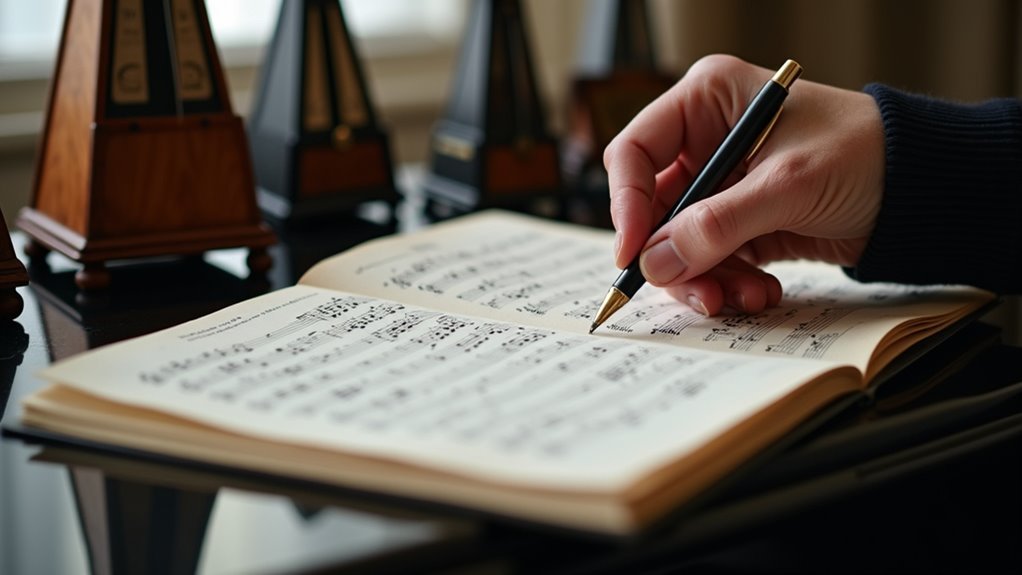Let’s get real about time signatures – they’re the DNA of music’s pulse and flow. We’ve all seen those mysterious stacked numbers at the start of sheet music, but they’re far more than mathematical puzzles. They’re our roadmap to rhythm, telling us exactly how many beats live in each measure and which notes get the spotlight. Whether you’re tracking a waltz’s gentle sway or steering through prog rock’s complexity, mastering these markers reveals music’s fundamental architecture.
Getting Started With Time Signatures

When you’re diving into music theory, time signatures are your essential first stop. Let’s break down these numerical gatekeepers that tell us exactly how to count our music.
Think of time signatures as the rhythmic DNA of a piece. They’re those two numbers stacked at the start of your sheet music – and they’re non-negotiable. The top number shows beats per measure, while the bottom tells us which note gets one beat. In 4/4, you’ll count four quarter notes per measure. Simple.
We’ll see 4/4 everywhere in pop and rock, while 3/4 rules the waltz. To read music effectively, you’ve got to nail these basics.
Music notation isn’t rocket science – it’s just a system waiting to be decoded, and time signatures are your key.
Common Time Signatures in Popular Music
But don’t ignore 3/4 time – it’s the signature that gives waltzes their distinctive swing, perfectly showcased in “My Favorite Things.”
For a more martial feel, there’s 2/4 time, powering Sousa’s “Stars and Stripes Forever.”
And when we need that flowing, lilting quality, we turn to 6/8 time, which divides measures into six eighth notes – just listen to Cohen’s “Hallelujah” for a masterclass in this signature.
The World of Compound Time Signatures

Diving into compound time signatures opens up an entirely new rhythmic dimension. We’ll tackle the fascinating domain of measures built on different groupings of eighth notes, where each beat subdivides into three parts.
| Time Sig | Grouping | Common Use |
|---|---|---|
| 6/8 | 2 x 3 | Folk Dance |
| 9/8 | 3 x 3 | Waltzes |
| 12/8 | 4 x 3 | Blues |
| 15/8 | 5 x 3 | Prog Rock |
| 18/8 | 6 x 3 | Art Music |
These compound time signatures create rhythmic patterns that pulse differently than their simple counterparts. Let’s get specific: 6/8 gives us two groups of three, perfect for lilting dances. 9/8 delivers three sets of three, while 12/8 powers blues with four groups of three. Master these, and you’ll reveal countless musical possibilities.
Exploring Irregular and Odd Time Signatures
As we venture beyond standard time signatures, irregular meters reveal a thrilling new world of rhythmic possibilities.
We’re talking about time signatures like 5/4, where you’ll find five notes in a bar instead of the usual four – just listen to Brubeck’s “Take Five” for a masterclass in how it’s done.
Want something even spicier? Try 7/8, a favorite in progressive rock that’ll have you counting in groups of 2+2+3 or 3+2+2.
And if you’re feeling particularly adventurous, there’s always 23/16 (yes, that’s a real thing – check out Ganondorf’s Battle Theme).
Different rhythms create different emotional impacts, and these irregular time signatures are your toolkit for breaking free from 4/4’s predictable constraints.
Think of them as musical puzzle pieces that fit together in unexpected ways.
Mastering Rhythmic Structure in Different Meters

While understanding different meters might seem intimidating at first, they’re really just patterns we can break down into manageable chunks.
Let’s start with common time signatures like 4/4, where we count four quarter beats per measure, and 3/4, which gives us three beats that create that distinctive waltz feel.
When we’re reading sheet music, we’ll notice how different meters shape the music’s flow. In 6/8 time, we’re working with six eighth notes per measure, creating a lilting, compound feel that’s different from straight time.
To master these patterns, we’ll need our trusty metronome – it’s non-negotiable. Practice emphasizing the strong beats in each measure, and you’ll start feeling how the music written in different meters naturally flows beneath your fingers.
Applying Time Signatures in Musical Performance
Now that we’ve got our rhythmic foundations down, let’s put these time signatures to work in actual performance.
We’ll start with the most common one – 4/4 time. Remember to put emphasis on that first beat of each measure; it’s your anchor point.
When we’re tackling 6/8 time, we’ll want to feel it in two main beats, with each divided into three. It’s like a musical waltz on steroids. Trust us – your performances will flow better this way.
Get that metronome clicking. It’s your best friend for internalizing these patterns, whether you’re working in standard 4/4 or tackling trickier signatures like 5/4 or 7/8.
The more time signatures you master, the more expressive your playing becomes. Your audience will hear the difference.
Frequently Asked Questions
How to Figure Out the Time Signature of a Bar?
We’ll identify the time signature by counting beats, recognizing rhythmic patterns, observing tempo indications, and exploring signature variations. Let’s analyze note values and beat groupings within each measure.
How to Understand Time Signatures in Music?
We’ll unfasten time signature basics by diving into counting beats and exploring meter variations. Let’s master musical notation to understand those mind-blowing rhythmic patterns that shape our understanding of music.
What Are the Bar Lines in Time Signatures?
We use bar lines as essential visual cues to organize rhythmic patterns and musical phrasing. They’re significant markers that impact our performance by showing where measures begin and end.
How Do You Read Music Bars?
We read music bars by following musical notation from left to right, understanding note values within the bar structure, counting rhythms according to meter patterns, and maintaining consistent timing.